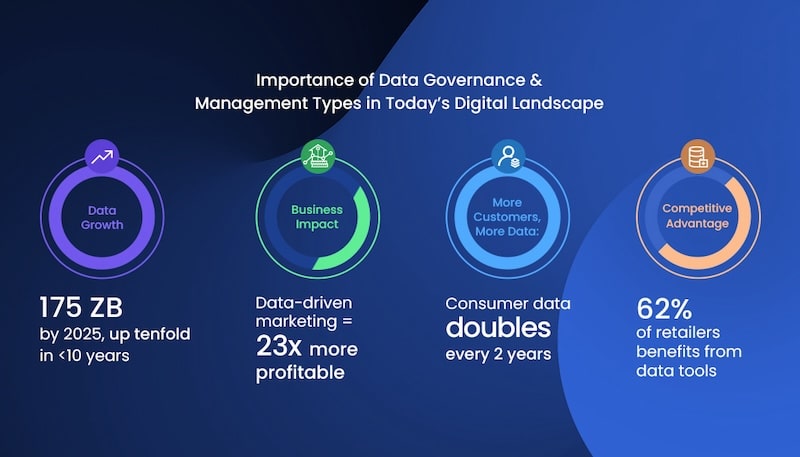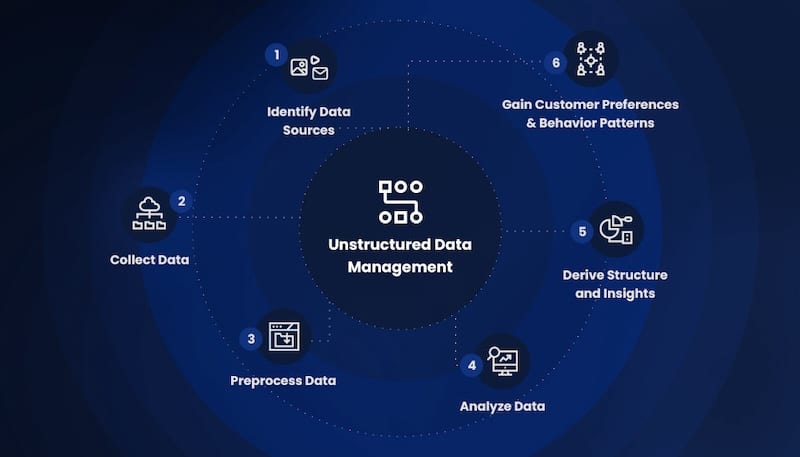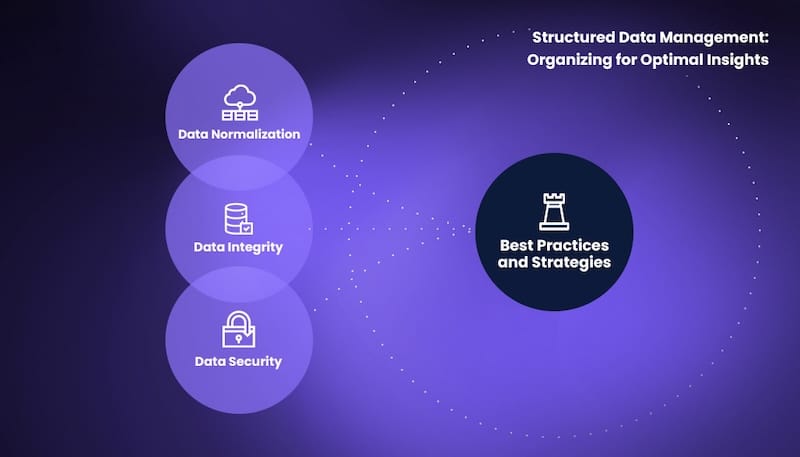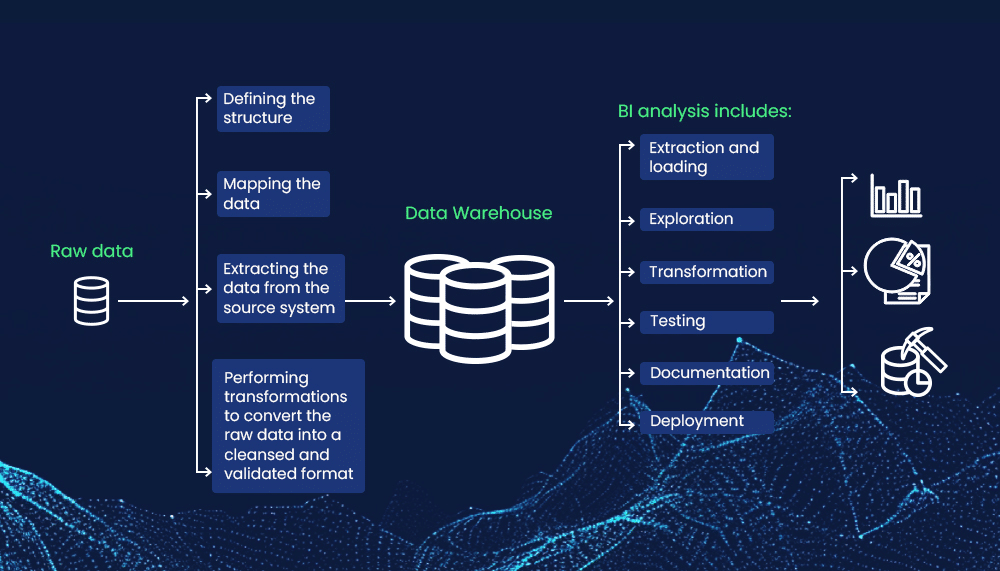In the information age, data is the backbone of businesses, influencing everything from day-to-day decisions to long-term strategic planning. Effective data management is crucial for leveraging this data to drive growth and maintain a competitive edge.
Different types of data management solve various challenges that your business might face. Whether you’re looking to store large volumes of data, unify data, or even model your data for a greater level of business intelligence.
Understanding the role of data architecture is fundamental in this context. It provides a structured approach to managing data flow through systems, ensuring efficient usage, storage, and compliance with governance standards.
The Importance of Effective Data Management for Business Success
Implementing different data management types helps growing businesses (like yours) scale by using data-driven processes. It can also turn your data challenges into competitive advantages. The growing interest in AI and the increasing accessibility of data-driven capabilities make a data management strategy essential and critical to success.
If your company implements a data management strategy, this guide will help you understand some of the most commonly used data management types. We’ll explore what data management is, the various types, the benefits of data management, and how others have used it successfully in their businesses.
Importance of Data Governance and Management Types in Today’s Digital Landscape
Data management has become more critical than ever. As businesses generate vast amounts of data, the ability to organize, analyze, and act upon this information sets successful companies apart from the rest. But don’t just take our opinion for it; let the data speak for itself:
- Data Growth: By 2025, the global data sphere will grow to 175 zettabytes, a tenfold increase in less than a decade.
- Business Impact: According to a Forbes report, companies that adopt data-driven marketing are 23 times more likely to be profitable year over year.
- More Customers, More Data: The amount of data consumers create doubles every two years.
- Competitive Advantage: 62% of retailers report gaining a competitive advantage from using data management tools

Effective data management enhances operational efficiency and improves decision-making by providing accurate, timely, and relevant information. Businesses can anticipate market trends, understand customer behavior, and optimize operations to outpace competitors. However, with all the benefits of data management come the risks associated with collecting it. Companies need to implement sound data management systems to not only survive but also ensure viability in the future.
High Costs of Neglecting Data Management Systems
Collecting data isn’t enough. Businesses collecting data need to implement data management processes that ensure the accuracy and safety of that data. Neglecting to implement a plan can lead to hefty costs and put the company at risk. Consider the facts:
- Poor Data Quality: Inaccurate data costs US businesses an estimated $3.1 trillion annually.
- Mismanagement: Poor data management processes reduce a company’s operational efficiency by 21%.
- Outdated data management costs businesses over $600 billion per year.
Beyond the financial implications, neglecting data management significantly threatens a company’s well-being.
Insufficient data storage and retrieval processes waste valuable time and resources for employees. Imagine marketing teams sending campaigns to outdated customer addresses or sales reps chasing down leads with inaccurate contact information.
An estimated 20% of database records contain contact data with data quality issues. Incomplete contact data alone results in a 77% revenue loss.
Inaccurate or incomplete data also leads to flawed business decisions. This can result in missed opportunities, the development of ineffective marketing campaigns, or even product launches that don’t meet customer needs.
Imagine a company launching a new fitness tracker riddled with errors. It might overrepresent the wrong age group or miss key features customers seek. This results in a product launch that misses its sales targets, wastes resources, and misses a potentially lucrative opportunity.

Risky Business
Data breaches are a constant threat in today’s digital landscape. These incidents can devastate businesses and consumers, from stolen credit card numbers to exposed customer information. Fortunately, there are steps companies can take to mitigate this risk.
Proper data management, secure storage, and compliance with regulations are essential to safeguarding data from breaches. This includes encrypting sensitive information, implementing access controls, and regularly monitoring systems for vulnerabilities. However, these measures are not enough.
Data governance is a crucial aspect of data management that ensures data availability, quality, compliance, and security, promoting accountability and enabling better business decisions.
It’s the overarching framework that establishes ownership, accountability, and processes managing data throughout its lifecycle. A well-defined data governance plan outlines who has access to data, how it should be used, and how it will be protected.
Without an effective data governance plan, businesses put stakeholders at risk for costly data breaches. Lax data practices can lead to unauthorized access, accidental exposure, and even insider threats. Data governance helps organizations identify and address vulnerabilities before malicious actors can exploit them.
Understanding Different Data Management Types that Help Your Business Grow
Structured, Unstructured, and Real-Time Data Management
Structured Data Management refers to the handling of data with a high degree of organization, such as databases where the format and length are fixed. This data type is easiest to search and organize, making it vital for operational reporting and performance tracking.
Unstructured Data Management, on the other hand, deals with data that lacks a predefined format or structure, such as social media posts, emails, or video content. Managing this type of data involves deriving structure from content that is not naturally organized, which can be crucial for gaining insights into customer preferences and behavior patterns.

Real-time data Management focuses on processing continuously updated data, allowing businesses to make decisions based on immediate data inputs. This is increasingly important in environments where conditions change rapidly, such as financial trading or emergency services.
Industry Examples Based on Real Use Cases
- Structured Data: A financial services firm used structured data management and specifically focused on data warehouses for efficient storage and retrieval. Integrating financial data streamlined its reporting processes. They achieved a 70% reduction in the time needed to generate compliance reports.
- Unstructured Data: A retail company implemented machine learning models to analyze customer reviews and social media stored in data lakes. This helped it tailor products to consumer preferences, leading to a 30% increase in customer satisfaction.
- Real-Time Data: A logistics company adopted real-time data tracking for its fleet. This involved using sensors on vehicles to collect real-time location and performance data. The data was then streamed into a centralized data warehouse for analysis. They optimized delivery routes, improving delivery times by 15% and reducing fuel costs by 10%.
Exploring Different Types of Data Management Strategies
Structured Data Management: Organizing for Optimal Insights
Defining Structured Data Management and Its Role
Structured data management involves strategies and practices for managing data in fixed fields within a record or file. This includes databases and spreadsheets critical for operational efficiency and statistical analysis.
Best Practices and Strategies
- Data Normalization: Ensure data is stored in a standardized format to facilitate access and analysis.
- Data Integrity: Implement validation rules to maintain the accuracy and consistency of data.
- Data Security: Use encryption and access controls to protect data from unauthorized access.

Case Study: How A Hearing Health Company Achieved Success with Structured Data Management
A leading hearing aid retailer saw explosive growth through structured data management. The company built a data management platform that centralized data pipelines from multiple sources to offer users a 360-degree view of their hearing health. They harnessed the power of their customer data integration and offered users a powerful tool to customize their hearing experience. Some of the key elements used were:
Centralized Data Management Platform: They built a central system to manage data pipelines from various sources. Some of the silos included its CRM systems, virtual visits, and hearing aid usage collected by the devices.
Defined Schema: The company structured its data based on a predefined format, or schema. This schema outlined the organization of the data, specifying data types (e.g., text, number, date) for each element.
Data Storage: The company used data warehouses to store data from each of its data sources.
Data Cleansing: Cleansing ensured data quality and accuracy when building databases. This involved removing duplicates or irrelevant data entries, standardizing formats, and correcting errors in data entry.
Data Processing and Analysis: Structure enabled the data to be segmented based on user, usage data, type of customer, and preferences. This made integrating data consistently and accurately into the company’s data management software easier.

Data Security: In the healthcare industry, protecting patients’ personally identifiable information (PHI) under HIPAA regulations required strict compliance. Access controls and data encryption helped maintain data security while preserving data integrity.
Unstructured Data Management: Extracting Value from Complexity
Understanding Unstructured Data and Its Challenges
Unstructured data is more difficult to analyze and requires more complex tools and techniques. Challenges include data capture, storage, and analysis.
Best Practices and Strategies
- Text Analytics: Use natural language processing to extract meaningful information from text.
- Data Lakes: Using data storage to enable diverse analytical approaches.
- Machine Learning: Employ machine learning to uncover patterns and insights within large datasets.

Case Study – Fashion Titan Tries to Patch Holes in Quality Issues
A major fashion retail company experienced a surge in customer complaints on social media about a defective product. These complaints were scattered across various platforms and expressed through text, images, and videos. Manually sifting through the complaints to understand customer concerns was time-consuming and inefficient. The company used the following elements in its data management system:
Data Collection: The system would need to be able to gather data from various social media platforms from which the complaints were coming. This involved APIs provided by the platforms or social media listening tools.
Data Storage: The company needed to store data in a way that could be analyzed. This involved a data lake designed to hold large amounts of complex data.
Data Integration & Cleaning: The raw data might need cleaning and preprocessing to remove irrelevant information and prepare it for analysis. This involved removing punctuation, converting text cases, and stemming words (reducing them to their root form). This step was critical to ensuring the fashion brand was working with high data quality to triage the problem.
Data Analysis: The solution used artificial intelligence recognition tools to automatically detect the faulty product in the complaints and narrow the data to only that product.
Ready for your own success story? Schedule a free, no-obligation consultation with one of our experts today!
Real-Time Data Management: Empowering Agile Decision-Making
Definition and Importance
Real-time data management involves processing data as it becomes available, enabling immediate analysis and response.
Best Practices and Strategies
- Stream Processing: Utilize tools like Apache Kafka and Apache Storm for real-time data feeds.
- Event-Driven Architecture: Build systems that respond dynamically to real-time data inputs.
- Data Visualization: Use dashboards to visualize and interpret real-time data for immediate action.

Case Study: Major Ride-Share Company Uses Data Management to Drive Business
A major ride-share company uses a system to manage real-time data for day-to-day operations. This includes customer data like location, number of riders, and preferred ride types. It also uses real-time data analytics from traffic reporting to optimize routes. The company used a real-time data management system to carry out several key elements:
Data Collection: data is collected from various sources, including user apps, vehicle GPS devices, and traffic management APIs.
Streaming Data: The platform uses stream processing techniques to handle the continuous flow of real-time data.
Data Processing: The collected data is analyzed in real-time using a combination of artificial intelligence machine learning algorithms.
Dynamic Pricing: The company uses the analyzed data to adjust fares dynamically based on demand and supply in specific locations. Its data management systems allow it to compete with other ride-share apps in the same areas.
Route Optimization: Real-time traffic data is factored into route planning, suggesting the faster and most efficient routes for drivers, leading to quicker pick-up times and reduced frustration.
Integrating Different Types of Data Management Solutions into Your Data Ecosystem
Integrating various data management types depends on a company’s specific data infrastructure and business goals.
The Foundational Layer: A Data Catalog
A data catalog acts as the cornerstone of your data ecosystem, making business data transparent, searchable, and easily accessible. It organizes data resources within a business using metadata, employing tags and labels for easy retrieval.
Data Transformation
Data processing is a critical stage where data scientists and analyst engineers collect and translate data into useful information. Dimensional data modeling, a crucial step in data transformation, organizes and presents data to make it easy for business analysts and users to analyze and understand. This step ensures accurate processing for sound decision-making.

Data quality takes center stage here, with practices like master data management playing a vital role in maintaining data governance and integrity. Master data management ensures consistency and accuracy across your entire data landscape.
Data Warehouse Insights
Data warehouses are crucial when managing large volumes of structured data. They excel at transforming raw data into valuable insights that empower informed business decisions.
Take the example of ride-sharing companies, fashion giants, or Jabra Enhance—all these entities leverage warehouses to glean insights that fuel growth and address challenges. While data warehouses and raw data integration tools are crucial, they are just pieces of the data management puzzle.
Expanding Your View with Real-Time Analytics
Consider integrating unstructured and structured data for a comprehensive picture of your business operations. Data lakes provide a central repository for housing both structured and unstructured data.
Additionally, layering real-time analytics on top of historical data analysis offers a dynamic understanding of your operations. This allows you to make data-driven decisions based on past trends and the ever-changing current landscape.
By selecting the right combination of data management tools, you can create a solution that perfectly aligns with your unique business goals and objectives. Remember, a well-designed data management system empowers your organization to unlock the true value of its data.

Case Study: Sustainable Building Materials Company Constructs Data Architecture
A leading manufacturer of sustainable building materials needed a robust data architecture to optimize efficiency and reduce waste. Data on raw material usage, machine performance, and product quality was scattered across different systems.
The company needed a holistic view of its operations but lacked real-time insights into production processes. To combat this, it implemented a system to address its data management challenges.
Data Catalog
The company built a catalog to document and organize information about its data sources, including data from sensors on production machines, quality control measurements, and inventory management systems. The catalog made data access and understanding easy across departments.
Data Transformation
A data integration platform was implemented to collect and centralize data from various sources. Data cleansing tools ensured data accuracy and consistency before analysis. Master data management software was adopted to standardize product specifications and material information.
Data Warehouse Insights
A data warehouse was established to store the transformed data. This allowed the manufacturer to analyze trends in production efficiency, material usage, and product quality defects. Insights from the data could reveal useful information like machine downtime, consumption, and batch identification with quality issues.
Real-Time Analytics
To gain real-time insights, the company integrated real-time analytics into their warehouse. This allowed them to monitor sensor data from production machines, track production line performance, and identify potential quality issues early on.
Common Challenges Companies Face Starting In Their Data Management Journey
The benefits of data management are undeniable. However, companies beginning their data journey face challenges, especially when going alone. Some common challenges you might face in the early stages include:
Vendor Lock-In and Agnostic Needs
Many data management solutions are tied to specific vendors. This can create a Vendor lock-in situation, where a company becomes dependent on a single vendor’s offerings. This limits their ability to switch or integrate with other valuable tools in the future. Ideally, companies need a vendor-agnostic solution. This allows for flexibility and integration with various data sources and analytics tools, future-proofing your data ecosystem.
Customization Is Key
Data needs and business goals vary greatly between companies. A generic “one-size-fits-all” data management solution isn’t possible, nor does it address an organization’s specific needs. Companies need a customizable approach to their data management systems.
This allows them to tailor the solution to their unique data landscape, industry, and business processes. Imagine a data management solution that adapts to your company, not vice versa.
Scaling for Growth
Data volume keeps coming. A data management solution needs to scale to accommodate your growth efficiently. Companies must consider solutions to handle increasing data loads without compromising performance or requiring frequent and expensive upgrades. Don’t get stuck with a solution that can’t keep up with your data explosion.
Seeing the Bigger Picture
Data management goes beyond just storing information. Companies need a holistic approach encompassing data collection, transformation, analysis, and visualization. The right solution should provide a comprehensive view of the entire data lifecycle. Think of it as a complete journey, not a storage locker.
Choosing the Right Types of Data Management System for Your Business Objectives
Navigating the world of data management solutions can feel overwhelming. With so many options available, choosing the right system that best fits your company’s needs is crucial. Here’s how you can get started.
Understand Your Data Landscape
Data volume and variety. The first step involves assessing the type and amount of data you collect. Are you dealing primarily with structured data (like customer records) or unstructured data (like social media posts)? The volume of data will also influence your choice. A small business might require a different solution than a large enterprise.
Business Goals. Clearly define your business objectives. Are you aiming to streamline operations, improve customer targeting, or gain insights into market trends? Understanding your goals will help determine the functionalities most important for your data management system.

Matching Needs with Solutions
Data Cataloging: For foundational organization, consider a data catalog. This tool creates a searchable index of your data assets, enhancing accessibility and transparency.
Processing and Quality: If data manipulation and ensuring data integrity are priorities, explore data processing tools and master data management solutions. These systems ensure your data is accurate and consistent throughout your entire ecosystem.
Data Warehousing and Data Analytics: A warehouse offers a powerful solution for in-depth analysis of large structured datasets. It transforms raw data into valuable insights that empower data-driven decision-making.
Unstructured Data Management: A data lake might be a valuable addition if you handle significant amounts of social media content or customer reviews. Data lakes provide a centralized repository for storing all types of data.
Real-Time Analytics: Consider implementing real-time analytics tools for businesses requiring insights into real-time operations. These solutions offer a dynamic view of your operations, allowing immediate adjustments based on current data.
By carefully evaluating your data landscape and business objectives, you can select the data management systems that perfectly align with your business needs. Remember, the ideal solution is a well-integrated data management ecosystem that empowers your organization to unlock the true potential of its data.
Taking the Next Step in Your Data Management Journey
Navigating the complex journey of managing your data doesn’t have to be daunting. Our experts can help you build your business’s right data management system. We make it easy using vendor-agnostic solutions tailored to your business goals and budget. Contact us for a free consultation.
Ready to enhance your business’s operational efficiency and decision-making through effective data management? Contact us today to discover how our data management solutions can transform your business. Also, consider subscribing to our newsletter for the latest insights and updates in data management.


